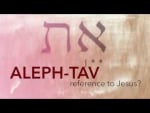The Aleph-Tav
In the book of Revelation Jesus said, “I am the Alpha and the Omega, the first and the last, the beginning and the end” (Rev 22:13). Alpha and omega are the first and last letters of the Greek alphabet—hence the “first and last” statement. For the Hebrew alphabet (reading right-to-left), the first and last letters are aleph and tav (את; or ʾt in English transliteration). Some preachers and internet researchers therefore claim that when the two letters aleph and tav appear together in the Hebrew Bible, they identify Jesus.

For example, In Genesis 1:1 the Bible says, “In the beginning God created the heavens and the earth.” Sounds simple. But there’s something in the Hebrew text that cannot be seen in English translations (Figure 1). Right before the words “heaven and earth” the aleph and tav appear together in the Hebrew text. They are left untranslated in all English versions. The reason, say aleph-tav believers, is that translators simply don’t know how to translate them.
 Figure 1
Figure 1
This example (among others) is proof, many claim, that the Old Testament encrypts Jesus at the creation of the universe, that it secretly positions Jesus as God’s agent of creation at the very beginning, something the New Testament says in several places (1 Cor 8:6; Col 1:16; Heb 1:2; John 1:1-3).
Does the presence of these two Hebrew letters really point to Jesus? Does the New Testament doctrine of Jesus as co-creator with God derive from two encrypted letters?
The Aleph-Tav: There’s No Mystery
The letters aleph and tav in Genesis 1:1 are not a mystery to translators, nor to anyone else who can read biblical Hebrew. They are not the encrypted Jesus. As any elementary biblical Hebrew grammar will explain, the aleph and tav combination is either a grammatical particle that marks the direct object (the accusative) in a sentence or a preposition. The former is the explanation for Genesis 1:1. The aleph and tav mark the “heavens and earth” as the object of the verb “created” in the sentence. The two letters are not translated because they have a grammatical function only. They are not supposed to be translated.
As the search image in Figure 2 illustrates, this untranslated “accusative particle” occurs nearly 11,000 times in the Hebrew Bible. It’s very well known to Hebrew scholars and translators. They understand exactly what it is. There’s no mystery.
 Figure 2
Figure 2
The aleph and tav (את) particle has a homograph in biblical Hebrew. A homograph is a word that is spelled exactly the same way as another word, but both words are distinct. Hebrew has homographs just like English does. An example in English would be bass. There is a “bass” for a type of fish and a “bass” that denotes a low, deep sound. They are entirely different words but spelled exactly the same.
The aleph and tav homograph is a preposition that means “with” in most usages. A biblical Hebrew lexicon (a specialized dictionary) will distinguish homographs with numbers so people looking up words are alerted to the fact that the spelling of a word they’re searching for is shared by an entirely different word.
The Aleph-Tav: Nothing Sacred
Neither the aleph and tav particle nor the preposition denotes anything sacred (like Jesus). Other Semitic languages (the language family of which Hebrew is a member) use the same two letters to mark direct objects or as a preposition.
Hebrew inscriptions that have nothing to do with the Bible have the aleph and tav. Languages of cultures that are “pagan” (e.g., Canaanites) from the biblical perspective have thealeph and tav (Figure 3).
 Figure 3
Figure 3
One useful example is the Moabite Stela (also known as the Mesha Stela). You can see how the aleph and tav particle marks the direct object in line 6 of the Moabite Stela (Figure 4):
 Figure 4
Figure 4
Reading right-to-left, the word immediately following the aleph and the tav is “Moab”. The underlined portion reads, “And he said, ‘I will also oppress Moab’.” The word “Moab” is the direct object (marked by the aleph and the tav particle) of the verb “oppress.” As with biblical Hebrew, Moabite used this particle to mark a grammatical function. It is not to be translated.
The point is that, if the aleph and the tav identified Jesus, it would be quite strange to have the same identifier in pagan literature. The aleph and the tav have nothing to do with Jesus. They form a simple, well-known, grammatical marker. The New Testament doctrine that Jesus was co-creator cannot be criticized on the basis of this flawed, erroneous assumption.
Resources:
Joüon, Paul, and Takamitsu Muraoka, A Grammar of Biblical Hebrew (Rome: Pontificio Istituto Biblico, 2003), 343 (§103k)
Friedrich Wilhelm Gesenius, Gesenius’ Hebrew Grammar (Edited by E. Kautzsch and Sir Arthur Ernest Cowley; 2d English ed.; Oxford: Clarendon Press, 1910), 362 (§117.a)
Humphrey H. Hardy II, "Whence come Direct Object Markers in Northwest Semitic?." Journal of Semitic Studies 61.2 (2016): 299-318
Charles R. Krahmalkov, “Phoenician ʾyt and ʾt,” Rivista degli Studi Orientali 66 (1992): 227–31
What is your response?


